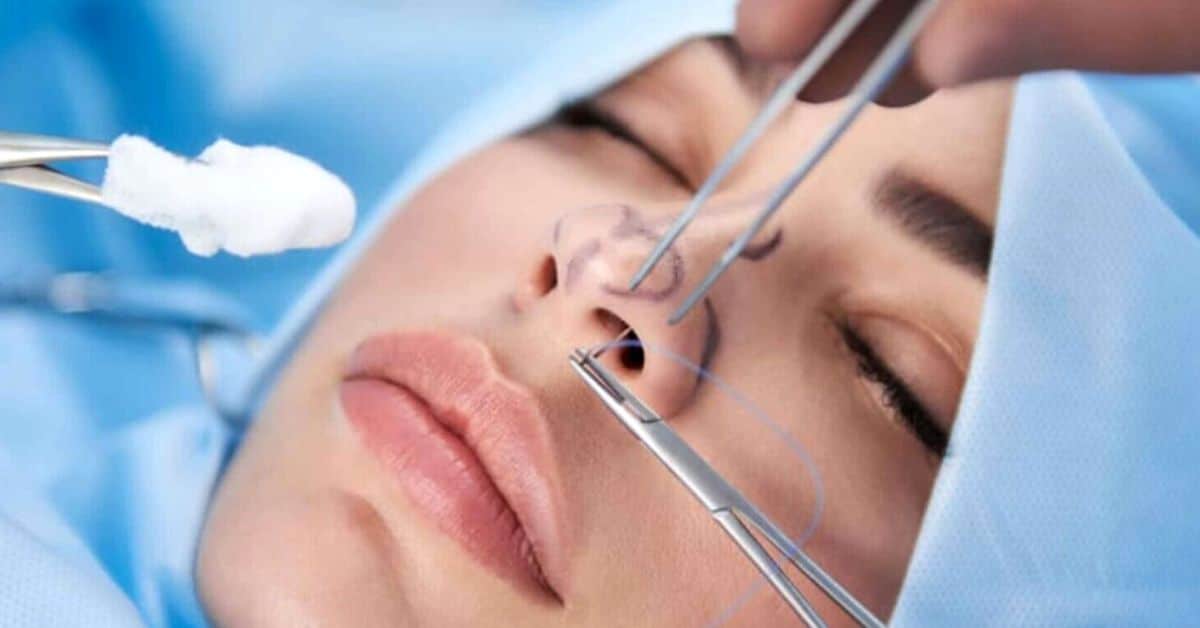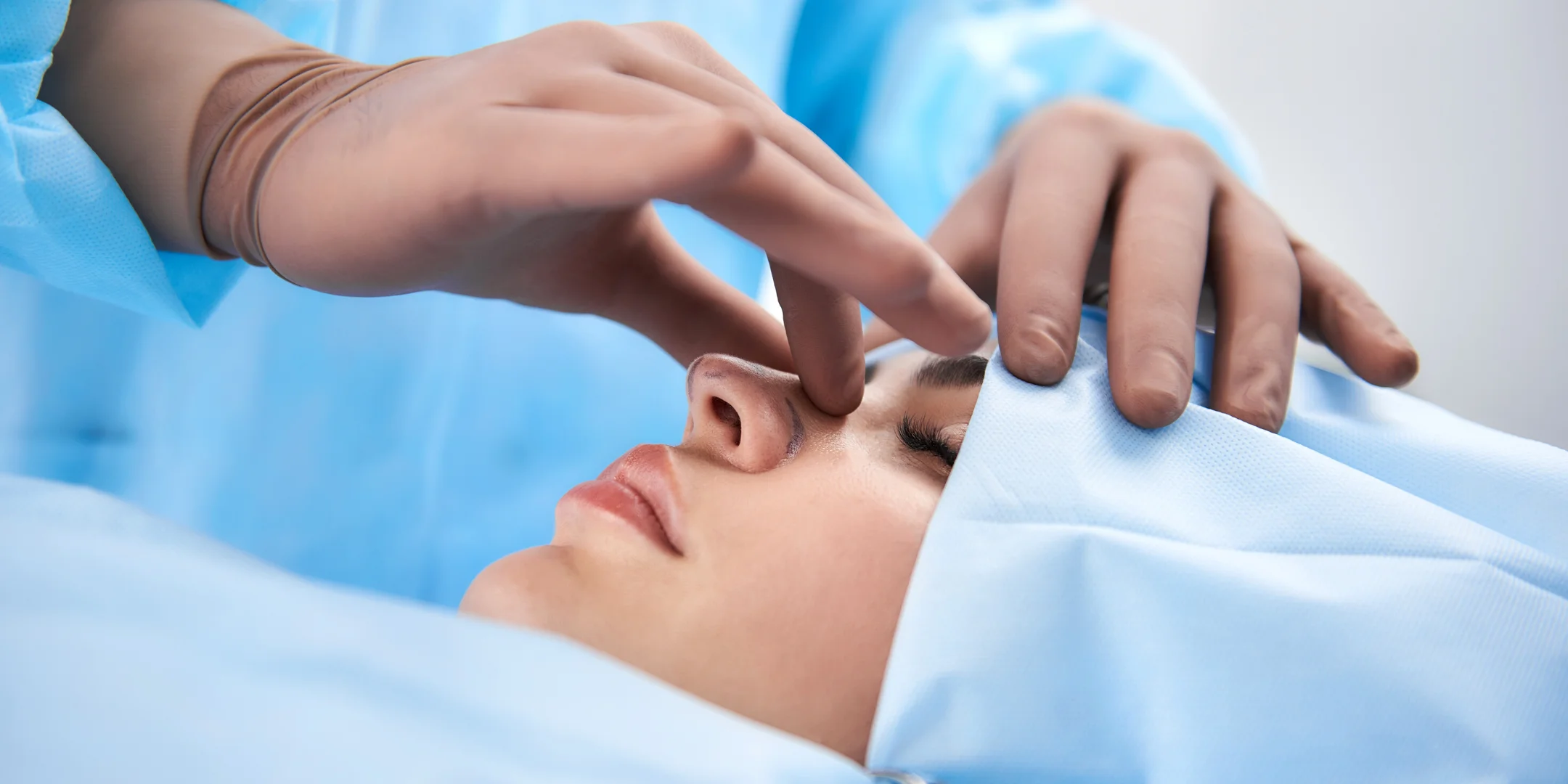A nose job is a procedure carried out on the nose to change its shape, size, improve its function, or enhance the nose’s appearance. The results are permanent.
The procedure can be performed for medical reasons, such as to correct breathing problems, disfigurement resulting from trauma, or congenital abnormalities. It also can be done for cosmetic reasons, which will modify the shape and appearance of the nose.
What is Nose Plastic Surgery?
The nose job, also called rhinoplasty, is a cosmetic surgery that reshapes your nose and enhances the overall appearance of your face. This meticulous technique ensures a beautiful, natural-looking result that can improve the look of your face permanently. This reconstructive procedure is also used to correct injuries, congenital abnormalities, and breathing issues.
Rhinoplasty can be a life-enhancing procedure when performed by a skilled, qualified cosmetic surgeon. Patients often notice an overall improvement in their appearance when they see how natural their nose looks and the nose they always intended they should have.
Reasons For Nose Surgery
People often choose rhinoplasty for a variety of reasons, including:
- Modifying the size of the nose by reducing or increasing
- Altering the bridge of the nose or the shape of the nose tip
- Narrowing the wide nostrils
- Modification of the angle between the nose and the upper lip
- Correct or straighten a crooked nose
- Correcting congenital abnormalities
- Repairing injuries/fixing a broken nose
- Relieving breathing problems by opening up blocked nasal passages
- Correct nasal asymmetry
- Upturned Nose
By reshaping the nasal structures (bone, cartilage, and skin), a cosmetic surgeon can help achieve the desired result.
Ideal Candidates for Rhinoplasty
Individuals who are generally in good health (physically and mentally) and have realistic expectations about the procedure are ideal candidates for rhinoplasty. The nose reshaping procedure is popular among the teenage population, and the age determined for the younger patients is at least 15 years. Patients must have a fully developed nose physically.
Patients of any age need to have realistic expectations. Rhinoplasty can help reshape your existing nose, but it cannot give “perfection” nor give you the nose of someone else.
A skilled, qualified cosmetic surgeon will explain what is possible and help you achieve a nose that looks natural for you.
Choosing a Rhinoplasty Surgeon
Rhinoplasty is an extremely complex procedure that involves a specially trained cosmetic surgeon. It is crucial to choose a surgeon with extensive expertise in facial cosmetic surgery and performs rhinoplasty significantly in their practice.
During the consultation with potential surgeons, you must inquire about their experience and the number of rhinoplasty procedures they have performed during their practice. It would help if you also looked at before and after photos of their patients to find out the surgeon’s aesthetic sensibility. The cosmetic outcomes should look natural for each patient. It could help you decide if the surgeon’s aesthetic sensibility aligns with yours.
Types of Rhinoplasty Procedures
Nose surgery is highly individualized, and the procedure chosen by a cosmetic surgeon will depend on the patient’s anatomy and desired changes.
Ethnic rhinoplasty helps modify your nose, creating a more natural appearance while complimenting and preserving your ethnicity. This technique is used to alter the nasal bridge, narrow or decrease the nostrils, or modify the nose angle.
A cosmetic surgeon’s techniques generally fall under one of the following procedural approaches:
Open Rhinoplasty
In an open rhinoplasty technique, a small incision is made under the tip of the nose, between the nostrils. This approach provides increased access to the nasal structures and a direct route for surgical manipulation. This approach is used for patients requiring more extensive reshaping.
After the surgical procedure, the scars are well-hidden in the natural contours of the nose and are less visible.
Endonasal Rhinoplasty
In a closed rhinoplasty or endonasal rhinoplasty, incisions are made inside the nasal passages (nostrils). This approach is often used for patients who need minor changes to the nasal structures to achieve the desired appearance.
There is no visible scarring, and the incisions are hidden after surgery. Since this approach offers a limited view, it may not be suitable for more extensive rhinoplasty procedures.
Tip Plasty
Tip Plasty technique is used to reshape the nasal tip only, without impacting other nasal structures. Open or closed rhinoplasty is used for tip plasty.
Rhinoplasty Procedure
Rhinoplasty surgery generally includes the following steps:
Step 1 – Anesthesia
Medications are administered during the surgical procedure. The procedure can be performed under general anesthesia or local anesthesia. General anesthesia will put you completely asleep throughout the procedure. Local anesthesia will make you lightly sedated (you will be awake), numbing your nose and the surrounding structures.
Your doctor will discuss the types of anesthesia used and recommend the best choice.
Step 2 – Incision
Rhinoplasty surgery is performed as an open procedure. The incision is created between the two nostrils or a closed procedure in which the incision is made within the nose.
The surgery generally lasts roughly one to three hours based on the technique used.
Step 3 – Reshaping the Nose Structure
If the goal is to reduce the size of your nostrils, small incisions are made at the base. The bone and cartilage are sculpted to get the desired shape.
Sometimes, the procedure may require additional cartilage grafts and may take the cartilage from the ear or rib.
Step 4 – Correcting a Deviated Septum
A deviated septum can be straightened and reduce the projections inside the nose to improve breathing.
Step 5 – Closing the Incision
After the nose is sculpted to the desired shape, nasal skin and tissue are redraped, and the incisions are closed with sutures. Additional incisions may be needed in the natural creases of the nostrils to modify their size.
Step 6 – Results
Splints and gauze packing are applied to support the nose and to maintain the new structure as it begins to heal.
Cartilage Grafts for Rhinoplasty
Cartilage grafts may be recommended during your surgery to provide structure or support. The removed cartilage is shaped as necessary and then re-inserted and sutured into certain locations in and around the nose.
The cartilage is typically taken within the nasal septum. Other potential sources include ear cartilage and rib cartilage.
More commonly used grafts during rhinoplasty include:
- Spreader graft
- Columellar strut graft
- Tip (shield) graft
- Alar rim graft
- Crural strut graft
- Dorsal Onlay graft
Recovery Process
Rhinoplasty is generally an outpatient procedure, and you may go home shortly after the procedure. Once the procedure is complete, a splint may be placed on your nose to support the newly reshaped nose and shield it from accidental contact. Temporary packing will be placed inside your nostrils and typically removed within the first week after the procedure. Your surgeon will order pain medication to alleviate discomfort during recovery.
The first 24 hours after the surgical procedure, you will experience aches in your nose and a dull headache. Your face will feel puffy. You can use pain medication to minimize discomfort. Most patients will be up and around within two days after surgery. The swelling and bruising will increase around your nose initially, and applying cold compresses will help reduce it and ease the pain.
A little bleeding is common initially on the first day or so. The discomfort level will improve quickly after two days of surgery, and may continue to feel nasal stuffiness for the first few weeks. All dressings, splints, and stitches are normally removed within a week after surgery.
You will notice a marked improvement in discomfort level during the first few weeks. Most patients return to work one to two weeks after surgery, depending on the level of activity. You must avoid engaging in any strenuous activities until your surgeon clears you.
Risks Associated With Nose Surgery
Like other surgical procedures, rhinoplasty has some associated risks, but major complications are unusual. Following the pre-op and post-op instructions provided to you may help reduce the risks.
Most likely risks include:
- Infection
- Nosebleeds
- Persistent swelling
- Asymmetry
- Need for further surgery
Rhinoplasty Combined With Other Procedures
Several surgical procedures are carried out along with rhinoplasty to enhance the overall facial appearance and give a younger look. These include:
- Facelift
- Eyelid lift
- Brow lift
- Chin enlargement
- Cheekbone enhancement
- Lip enhancement
Cost and Insurance Coverage For Rhinoplasty
One of the most crucial factors is the cost. The average cost of rhinoplasty is about $5000 to $7000. The total price may vary based on the location, the surgeon’s skill, the goal of the surgery, and the type of anesthesia used.
Cost for primary rhinoplasty procedure may include:
- Surgeon’s fee
- Anesthesia fees
- Hospital or surgical facility costs
- Pre-surgical clearance and medical tests
- Post-surgery garments
- Prescriptions for medication
Remember, the surgeon’s experience and comfortableness are just as important as the final cost of the surgery.
The insurance company may cover a rhinoplasty procedure in some cases when performed for medical purposes to improve breathing function. Whether the procedure is carried out separately or in combination with cosmetic rhinoplasty, it is considered reconstructive and covered by insurance.
A detailed examination is done to verify the cause of breathing impairment and prior authorization from the insurer.
Deciding on a Nose Job
If you consider getting a nose job, set up an appointment with your surgeon and talk about your goals and how you would like to change them. Learn about non-surgical alternatives to nose jobs.
Remember, there is nothing such as a perfect nose. Surgery can enhance facial features and create facial balance and correct proportion. A plastic surgeon can describe your unique facial features and tell you how changes would enhance your appearance. If you already had a nose job, then consider revision rhinoplasty for the desired outcome.
Finally, here is some post-operative advice for rhinoplasty recovery to prepare you for an important decision.
Reference
https://www.webmd.com/beauty/cosmetic-procedures-nose-job-rhinoplasty#1









